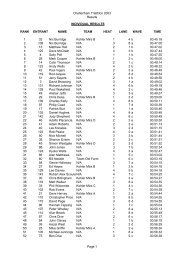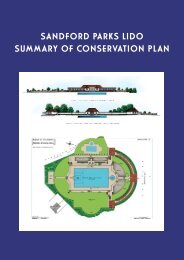heritage leaflet.pdf - Sandford Parks Lido
heritage leaflet.pdf - Sandford Parks Lido
heritage leaflet.pdf - Sandford Parks Lido
Create successful ePaper yourself
Turn your PDF publications into a flip-book with our unique Google optimized e-Paper software.
<strong>heritage</strong> <strong>leaflet</strong>.qxp 19/06/2007 09:21 Page 13Very few lidos of the inter-war period had heating systems for their water. Perhaps peoplereally were hardier then. The heating of the pool was a unique feature and one of the firsttasks of the staff was to stoke the coal fire boiler. As many lidos in the country remainunheated, visitors to <strong>Sandford</strong> <strong>Parks</strong> <strong>Lido</strong> are oftensurprised that the pool water is heated. (see page22)The traditional lifeguard uniform is very differentto that of today. One regular customer can recall alifeguard attempting a rescue and then himselfneeding assistance as he struggled to swim in thecumbersome uniform along with a very heavy thickrope.Staff from the opening season The café was built using some of the £1,000 profitfrom the first lido season. During the opening ceremony six willow saplings were planted.The willows were a gift from the Isle of Elba. An additional section of land was taken from<strong>Sandford</strong> Park to create the Children's Pool.The lido remained operational during the war years and wounded servicemen were broughtto several extra hospitals improvised in Cheltenham. Exhausted soldiers from Dunkirk werealso sent here to recuperate. A tattered cockney sergeant resting his men before their nextposting described the <strong>Sandford</strong> Pool as "Heaven after Hell". In 1942 America joined the warand the pool car park was turned into a petrol depot to supply their convoys passing through.Two ropes were fixed down the centre of the car park to make a path for bathers, except onoccasions when the area was required for testing survival equipment, which was done inclose secrecy. Records show that, in spite of war-time, an average of 90,000 people visitedthe lido between 1943 and 1945.After the opening of the indoor swimming facilities in Cheltenham in 1971 the future of thelido came into question. There were times when the lido would break even or show a slightsurplus. However, after a poor summer in 1982 the lido faced the first calls to close or tosell the site. Supporters rallied round, petitioned the council and the lido was protected forthe next few years. In 1983 and 1984 attendance levelstotalled over 232,000, proving the decision tobe a good one.Repairs carried out in 1996Structural surveys were carried out that uncoveredserious cracks in the pool tanks and theLocal Authority was finding it difficult to justifythe level of expenditure required. Unsuccessfulrepairs were carried out in 1989 and 1994 but itwas estimated that £250,000 was needed to maintainthe ageing structure.12












